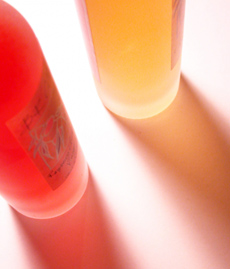

Bottle of red, bottle of white. Wine vinegars, along with balsamics, are most popular with foodies. On a mass basis, cider vinegar and distilled white vinegar are the big sellers. Photo courtesy SXC.
|
By day, DAVID SCHOENBERGER is a marketing executive for a Fortune 500 financial services company. By night, he is an ideation consultant, an entrepreneur and a writer on food and fun. His writing can be found in Self and Glamour.
|
|
June 2005
Updated July 2008
|
 |
Vinegar 101
From The Old Testament to Today’s Food Bibles
Page 1: The History Of Vinegar
CAPSULE REPORT: Gourmet vinegar is a great condiment. It can transform a dish, elevate a sauce, make just another green salad into something special. Some vinegars are so fine, you can drink them straight (read about Austria’s Gegenbauer vinegar, a NIBBLE Top Pick Of The Week, which is made like a fine wine). This is page 1 of a five-page article, concluding with the different types of vinegar. Click on the black links below to visit other pages.
If products were people, then vinegar would have good reason to lie about “her” age: “she” is over 10,000 years old! Vinegar has a legacy that goes back—way back—to ancient times, where it was inadvertently created alongside its alcoholic forbears—wine, beer, and other spirits. Vessels with traces of vinegar dating back to 6000 B.C.E. have been found in Egypt and China.
First written about in Babylonian times circa 5000 B.C.E., vinegar made with dates* found its way to kitchens and campfires everywhere. One legend has Cleopatra, to win a bet with Marc Antony, dissolving a pearl in a glass of vinegar and quaffing the mixture.
What we can be sure of, however, is that vinegar is mentioned—twice—not in a mere ancient cookbook but in the mother of all books, the Bible (in both the Book of Ruth and in Proverbs). It is specifically called for in the Talmud, to make the haroseth for Passover.
Hippocrates prescribed a watered-down vinegar drink to his patients. Caesar’s army, drank it too; although as a preventative medicine, not as a palliative. Some scholars believe that Jesus, while on the cross, was given a drink of vinegar with water as a painkiller.
Modern Vinegar
In 1896, Henry J. Heinz founded a condiment company selling prepared horseradish, pickles and various sauces. The company also manufactured vinegar to preserve the pickles. Soon enough, Heinz was the first manufacturer to package vinegar in individual bottles for home use. In the early 1880s, the “paneled” bottle with the keystone label appeared.
Previously, all vinegar was fermented in barrels or crocks that were stored in barns or basements. According to a 1901 H. J. Heinz Company employee newspaper: “The old vinegar barrel lying in the cellar, or at the side of the barn for three or four years, has been supplanted by appliances that retain the natural flavor of the fruit and keep it free from impurities of all kinds. Cleanliness, purity and wholesomeness—the secret of HJ Heinz Company’s great success in making vinegar.”
*Vinegar requires a fermentation of sugar, and can be made from almost anything that contains it: fruits (apples, berries, coconuts, grapes, melons, peaches), grains (sorghum, rice, barley malt), whey, sugars (molasses, sugar cane, honey, maple syrup), or vegetables (beets, potatoes). The most commonly used varieties—not necessarily by foodies—are apple cider vinegar and distilled white vinegar.
Vinegar: Made From Much More Than Wine
While most people think of vinegar as something that is made from wine, it can be made from the fermented juices of virtually any plant material, including rice, grain and fruit. Thus, while European vinegar is basically an alcoholic beverage that has gone sour, and the word vinegar that we use today is French for sour wine (vin is wine and aigre means sour), around the world vinegars are made from a broad variety of bases. Any liquid containing sugar and starch can conceivably be made into vinegar once alcohol fermentation has begun. Different cultures make vinegars made from their local produce, fermenting dates, honey, raisins, rose petals, sorghum and sugar cane.
Whatever language one speaks, cultures the world over use vinegar in meals as part of marinades, sauces, salsas, mustards, ketchups, relishes, chutneys, sambals, jellies, jams, and preserves—not to mention as a cleaning agent, disinfectant, and medical treatment (which we won’t be dwelling on any more in this article—we’re here to eat). Unopened bottles of vinegar can be stored indefinitely. Producers recommend that opened bottles should be used up within 6 months to enjoy peak flavor; although we have kept vinegars much longer than that (years!). All bottles should be kept in a cool, dark place—including those gourmet bottles with sprigs of herbs inside. You need to choose if they’ll be food or decor, since daily exposure to bright light can alter the flavor over time.
Continue To Page 2: How Vinegar Is Made
Go To Article Index Above
Lifestyle Direct, Inc. All rights reserved. Images are the copyright of their individual owners.

|


